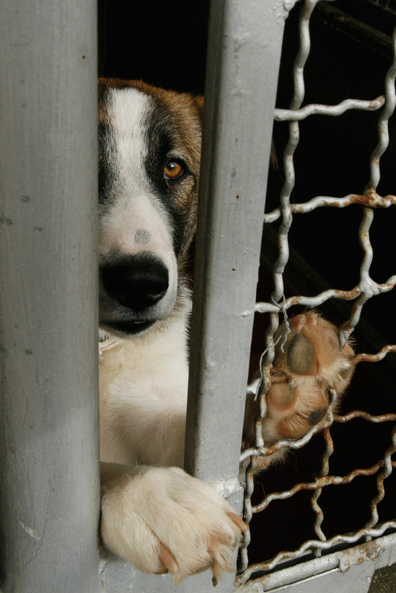The views expressed in our content reflect individual perspectives and do not represent the authoritative views of the Baha'i Faith.
Compassion, in which ethics takes root, does not assume its true proportions until it embraces not only man but every living being. – Albert Schweitzer, 1952 Nobel Peace Prize speech.
 We humans began domesticating animals as early as 9000 B.C. But for many, many thousands of years before that, people and animals existed as competitors, enemies and fearsome antagonists. Our ancestral memory of that relationship—when an animal was just as likely to eat a human as vice versa–may explain why human cruelty to animals still persists in some places. It took our species a very long time to stop treating animals so terribly, and we’re still working on it.
We humans began domesticating animals as early as 9000 B.C. But for many, many thousands of years before that, people and animals existed as competitors, enemies and fearsome antagonists. Our ancestral memory of that relationship—when an animal was just as likely to eat a human as vice versa–may explain why human cruelty to animals still persists in some places. It took our species a very long time to stop treating animals so terribly, and we’re still working on it.
As far back as 1789 the philosopher Jeremy Bentham made this argument concerning the welfare of animals: “The question is not, can they reason? Nor, can they talk? But, can they suffer?” These were serious questions, especially when most people believed, as did Descartes, that nonhuman creatures had no spirit, mind or reason, and couldn’t feel pain or experience emotions.
But Bentham’s questions, and the work of several artists and writers who graphically depicted cruelty to animals, started a revolution in the way we think about the lives of the “beasts of the field.”
Within a few decades, activists had formed organizations like the Royal Society for the Prevention of Cruelty to Animals (the modern-day SPCA) in 1824. One historian called that “the first consciously organized action taken by any species of life on Earth solely for the benefit of another.” A half-century later, when Darwin’s theory of evolution first became known, many more thinkers and philosophers began opposing society’s harsh and cruel treatment of animals—primarily because evolution showed that many animals, especially the higher primates, were our relatives. During that period–in exactly the same era as the birth of the Baha’i Faith–a global movement to stop animal cruelty began in earnest.
Science has advanced enormously since then, and we now know that many animals have complex emotions, can communicate with one another, use tools and have a well-developed sense of self-awareness. Mammals like primates, canines and dolphins can even develop a rudimentary understanding of human speech. As a result of all this newly-expanded scientific and humanitarian understanding of the lives of animals, many societies and cultures have implemented and enforced humane laws regulating their treatment and welfare.
The Baha’i teachings, from their beginnings in the mid-1800s, have also strongly advocated the prevention of cruelty to animals. In fact, the Baha’i writings ask everyone to be even kinder to animals than they are to their fellow humans:
Briefly, it is not only their fellow human beings that the beloved of God must treat with mercy and compassion, rather must they show forth the utmost loving-kindness to every living creature. For in all physical respects, and where the animal spirit is concerned, the selfsame feelings are shared by animal and man. Man hath not grasped this truth, however, and he believeth that physical sensations are confined to human beings, wherefore is he unjust to the animals, and cruel.
And yet in truth, what difference is there when it cometh to physical sensations? The feelings are one and the same, whether ye inflict pain on man or on beast. There is no difference here whatever. And indeed ye do worse to harm an animal, for man hath a language, he can lodge a complaint, he can cry out and moan; if injured he can have recourse to the authorities and these will protect him from his aggressor. But the hapless beast is mute, able neither to express its hurt nor take its case to the authorities. If a man inflict a thousand ills upon a beast, it can neither ward him off with speech nor hale him into court. Therefore is it essential that ye show forth the utmost consideration to the animal, and that ye be even kinder to him than to your fellow man.
Train your children from their earliest days to be infinitely tender and loving to animals. If an animal be sick, let the children try to heal it, if it be hungry, let them feed it, if thirsty, let them quench its thirst, if weary, let them see that it rests. – Abdu’l-Baha, Selections from the Writings of Abdu’l-Baha, p. 158.
This level of loving-kindness, so essential and central to the Baha’i teachings, treats all living beings with compassion and consideration. It requests that we try to live in harmony with nature. It asks us to “be numbered among the gentler animals:”
Therefore should every servant of the One God be obedient to the law of love, avoiding all hatred, discord, and strife. We find when we observe nature, that the gentler animals group themselves together into flocks and herds, whereas the savage, ferocious creatures, such as the lion, the tiger, and the wolf, live in wild forests, apart from civilization. Two wolves, or two lions, may live amicably together; but a thousand lambs may share the same fold and a large number of deer can form one herd. Two eagles can dwell in the same place, but a thousand doves can gather into one habitation.
Man should, at least, be numbered among the gentler animals; but when he becomes ferocious he is more cruel and malicious than the most savage of the animal creation! – Abdu’l-Baha, Paris Talks, p. 139.
















Comments
Sign in or create an account
Continue with Googleor